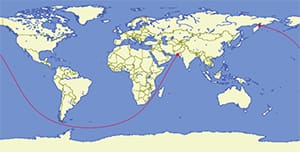Many long-distance voyagers relish a challenge, but sailing the longest possible straight line on Earth probably won’t end up on many bucket lists.
The route, recently confirmed by two scientists, covers almost 20,000 miles from Sonmiani, Pakistan, to Karaginsky District, Russia. It passes between Madagascar and Africa’s east coast, under the Cape of Good Hope and Cape Horn, then north through a lonely stretch of the Pacific to the Kamchatka Peninsula.
Rohan Chabukswar and Kushal Mukherjee set out to confirm the Earth’s longest sailable straight line, spurred largely by a map that emerged on Reddit in 2012 purporting to show the answer.
That map, according to the paper published in April, “generated a lot of interest and led to subsequent attempts to prove and disprove the user, along with discussions on solving the converse problem of determining the longest distance that can be driven on land without hitting a major water body.”
Ultimately, they confirmed the Reddit map.
Chabukswar, who works at United Technologies Research Center Ireland, and Mukherjee of IBM Research India consider this an optimization problem.
 |
|
The straight line route, shown here in three parts, starts near Sonmiani, Pakistan, and runs to Karaginsky District, Russia, on the Kamchatka Peninsula. |
“The first step in formulating the problem was to implement a method for enumerating the different straight line paths on the Earth,” the paper said. “To do this, it is important to note that all straight line paths lie on a great circle.
“Each great circle can have as many paths as there are crossings of the great circle with the land-water boundary,” the researchers continued, “but since the interest lies in only the longest paths (either land or water) in each great circle, enumerating all the great circles would be enough.”
Rather than consider the more than 233 million possible great circles around the globe — and more than 5 trillion points they comprise — the researchers used complex mathematical models to arrive at the answer.
“The algorithm returned the longest path in about 10 minutes of computation for water path, and 45 minutes of computation for land path on a standard laptop,” according to the paper.
The longest path one could travel over land, the researchers found, covers 6,984 miles from Jinjiang, China, to Sagres in southwest Portugal.
Finally, the researchers make clear this was an academic exercise. “The authors do not recommend sailing or driving along the found paths,” the report concludes.
To see their work, visit arxiv.org/pdf/1804.07389.pdf.

